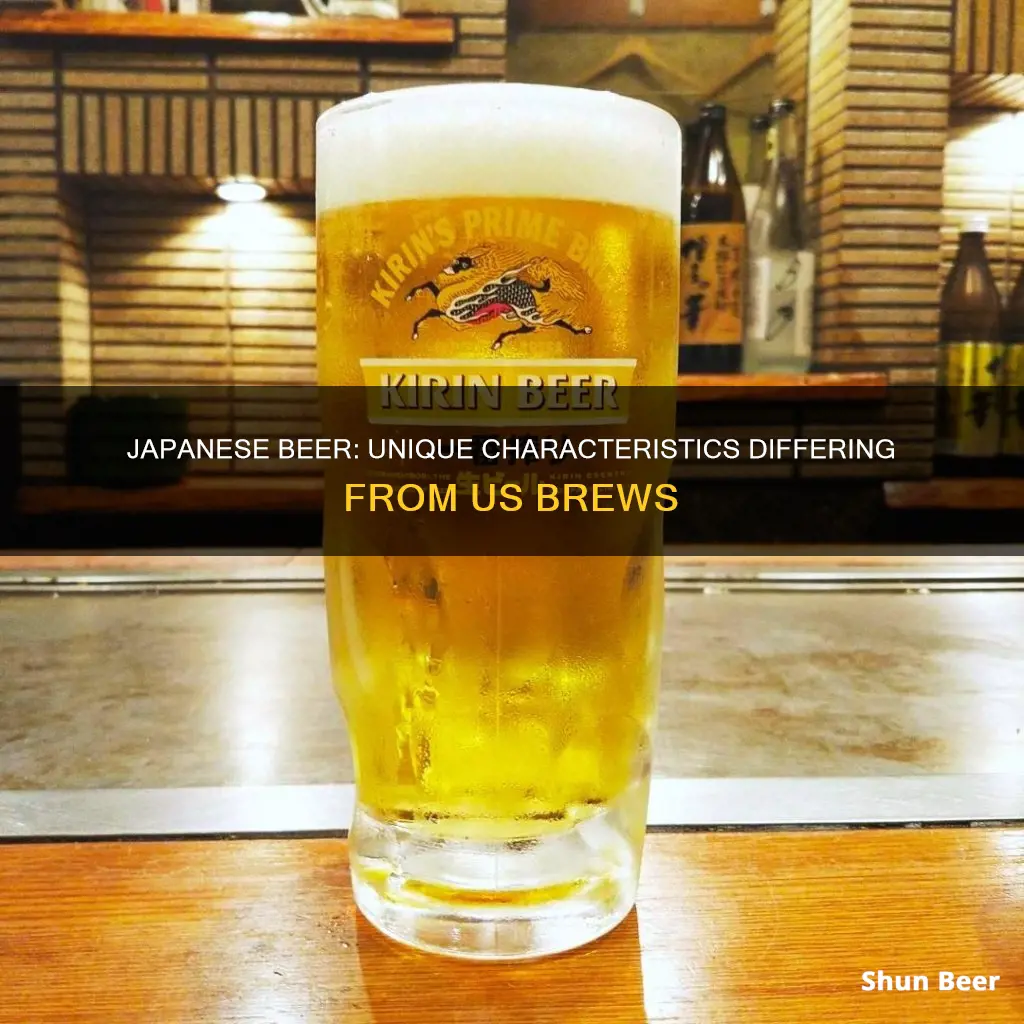
Japanese and American beers differ in several ways, from their flavour profiles to their production processes. Japanese beer is known for its lighter, fresher taste, often achieved by substituting rice for grain in the brewing process, resulting in lower malt content. This approach aligns with the Japanese palate and complements the country's cuisine, particularly deep-fried and umami-rich dishes. In contrast, American beers, including the big brands, tend to fall on the bolder end of the flavour spectrum. Japanese beers are also modelled on European styles, initially using traditional European brewing practices, while American beers may showcase a broader range of flavours and styles.
| Characteristics | Values |
|---|---|
| Taste | Japanese beer is considered to have a lighter and fresher taste than American beer. |
| Ingredients | Japanese beers often contain rice in addition to the standard ingredients of water, hops, yeast, and grains. |
| Style | Japanese beer is typically a pale lager, with an alcohol content of around 5%. |
| Categories | Japanese beers are categorised into four types: regular beer, happoshu (low-malt beer), new genre (third beer), and craft beer. |
| Taxation | Japanese beer is taxed based on malt content, which has led to the development of low-malt and non-malt alternatives. |
| Availability | Japanese beer is widely available in the US, with all four major Japanese brands (Sapporo, Kirin, Asahi, and Suntory) being present in the market. |
| Craft Beer Scene | Japan, particularly Tokyo and Osaka, has a vibrant craft beer scene, with a focus on local and imported beers. |
What You'll Learn
- Japanese beers are often lighter and fresher-tasting due to the addition of rice to their recipes
- Japanese beer is typically a European-style lager
- Japanese beer is categorised into four types, including regular beer, happoshu, new genre, and craft beer
- Japanese beer uses seasonal and local ingredients, with some beers unique to certain prefectures
- The Japanese craft beer scene emerged in the mid-1990s, with Tokyo and Osaka at its heart

Japanese beers are often lighter and fresher-tasting due to the addition of rice to their recipes
Japanese beers are often lighter and fresher-tasting than their American counterparts due to the addition of rice to their recipes. Beers typically consist of hops, barley or malt, yeast, and water. However, Japanese beers like Sapporo and Asahi contain at least a third rice in their recipes. This addition of rice lends a light, fresh taste that is easily accessible to a wide range of beer drinkers.
There are several reasons why brewers use rice in their recipes. Firstly, barley, a common grain in American beer, can make the beverage cloudy due to its high protein content. In contrast, rice has significantly less protein, resulting in the clear appearance associated with Japanese beers. Additionally, rice has a neutral flavour that adds a subtle hint of sweetness without overwhelming the other ingredients. This allows hops, like the Sorachi Ace hops created by Sapporo, to shine through and contribute a slightly lemony taste.
The use of rice in Japanese beer can be traced back to the country's history and the influence of German brewing traditions. When Japanese brewers began making beer in the 1800s, they looked to Germany for inspiration and imported German brewing equipment and brewmasters. At the time, Japan had an abundance of high-quality rice but lacked a sufficient supply of barley. As a result, brewers started incorporating rice into their recipes, creating a unique style of lager that is now known as Japanese lager.
Brewing with rice presents some challenges as brewers must convert the starches to fermentable sugar. Brewers use various techniques, such as cooking the rice before adding it to the mash or using rice syrup solids, to overcome these obstacles. The addition of rice also affects the taxation of beer in Japan. If a beer contains more than one-third rice, it is classified as a "happoshu" and taxed at a lower rate than traditional beer.
The light and refreshing qualities of Japanese rice lager make it particularly well-suited for warm weather and summer heat. Its delicate nature and subtle flavours contribute to its drinkability, making it a popular choice for social gatherings and catching up with friends.
Beers Around the Globe: Exploring the Varieties
You may want to see also

Japanese beer is typically a European-style lager
Beer was first introduced to Japan by Dutch traders in the 17th century, and major breweries such as Kirin Brewery Company and Sapporo Brewery emerged during the Meiji Period, leading to the mass production of various beer styles. While Japanese beers today are mainly rice lager types, the country's brewing techniques have evolved over time, incorporating various ingredients and styles.
Most Japanese beers, including pale lagers, are made with malt, hops, yeast, and water, with rice being a key ingredient that gives them their light and clean flavour. The craft beer movement in Japan has also led to experimentation with different styles and techniques, blending tradition and innovation.
In addition to the classic rice lagers, Japanese brewers have adopted and mastered European beer styles. Japanese beers are often based on German models, including ales and lagers such as pilsners and stouts. The adherence to traditional European ingredients and processes, combined with the modern use of rice, has resulted in unique floral and aromatic beers with a light body and crisp finish.
The Japanese beer market is dominated by several "macro-breweries" such as Sapporo, Asahi, Kirin, and Suntory. However, there has also been a boom in previously illegal microbreweries, offering unique and innovative beer styles to cater to diverse tastes. The rise of craft breweries and microbreweries has brought a wave of new flavours and styles to the Japanese beer scene, making it an exciting time for beer enthusiasts in the country.
Heineken's Unique Brewing Process: What Sets it Apart?
You may want to see also

Japanese beer is categorised into four types, including regular beer, happoshu, new genre, and craft beer
Japanese beer is categorised into four types: regular beer, happoshu, new genre, and craft beer.
Regular beer, or beer as it's known in Japan, is the most popular alcoholic drink in the country. Typically, it's a light lager with an alcohol content of around 5%. Beer is taxed according to its malt content, so regular beer, with its higher malt content, is taxed more than happoshu and new genre.
Happoshu, or "sparkling alcohol", is a low-malt beer with a similar flavour and alcohol content to regular beer. However, it has a lighter taste due to the reduced malt. Happoshu was created in 1997 when beer prices started to increase, providing a cheaper alternative. The tax on happoshu ranges from 47 yen to 77 yen per can, depending on the malt content.
New genre, or "third beer", is a more recent development and doesn't contain any malt. Instead, it uses pea, soy, or wheat spirits, allowing it to be sold at an even lower price than happoshu. The alcohol tax rate is currently being adjusted and, by 2026, all beer and beer-like beverages will have a unified tax rate, narrowing the price difference between regular beer and its alternatives.
Craft beer, or "local beer", emerged in the mid-1990s after a relaxation of stringent brewing laws that previously only granted licenses to large-scale brewers. Since then, craft beer has become popular, with hundreds of microbreweries across Japan selling high-quality regional beers domestically and abroad.
Understanding Beer Strength: 3.2% vs Regular
You may want to see also

Japanese beer uses seasonal and local ingredients, with some beers unique to certain prefectures
Japanese beer is known for its use of seasonal and local ingredients, with some beers unique to certain prefectures. The country's craft beer scene emerged in the mid-1990s, following the relaxation of strict brewing laws that had previously only granted licenses to large-scale brewers. This change allowed small-scale breweries to thrive, and today there are hundreds of microbreweries across Japan, with a particularly vibrant scene in cities like Tokyo and Osaka.
Many Japanese craft beers showcase local and seasonal ingredients, reflecting the emphasis on craftsmanship, quality, and ingredient provenance often associated with Japanese food. This focus on local ingredients is also seen in Japanese cuisine, where each region has its own distinctive culinary style and regional dishes.
In addition to craft beers, Japan also has four major breweries: Asahi, Kirin, Sapporo, and Suntory. These breweries mainly produce pale lagers with an alcohol content of around 5%, and their beers are widely consumed at homes and drinking establishments nationwide.
The alcohol laws in Japan dictate that beer is taxed according to its malt content, so Japanese brewers have created beer-like drinks with less malt, which are cheaper to sell. These drinks, known as "happoshu" or "low-malt beer", have a similar flavor and alcohol content to beer but with a lighter taste.
The availability of local ingredients, combined with the relaxation of brewing laws and the development of craft beers, has contributed to the growing diversity of Japan's beer market. This diversity is reflected in the unique beers found in different prefectures, showcasing the creativity and innovation of Japan's brewers.
Sour Beers: A Unique Fermentation Process
You may want to see also

The Japanese craft beer scene emerged in the mid-1990s, with Tokyo and Osaka at its heart
Osaka's Craft Beer Scene
Osaka, known as the economic powerhouse of Kansai, has a thriving craft beer culture. The city's historical nickname, "Kuidaoremachi" or "eat until you drop town", reflects its vibrant food and drink scene, which includes a diverse range of craft beer establishments.
One of the pioneers of Osaka's craft beer scene is Beer Belly, a well-known craft beer bar in Tosabori that has been operating since 2016. Beer Belly brews its own beer on-site and offers a warm and inviting atmosphere. Another notable establishment is Kamikaze in the Kitahorie district, known for its extensive selection of beers from all over Japan and its delicious food. Hathor in Kyobashi is also worth mentioning, offering 16 taps of Japanese and international craft beers, along with a cosy atmosphere and tasty bar food.
Osaka is also home to Minoh Beer, one of the city's best-known craft beer breweries. Founded in 1997 by Oshita-san for her daughters, Kaori and Mayuko, Minoh Beer has garnered recognition beyond Osaka, with its W-IPA advertised in a Japanese newspaper. The brewery has won multiple awards, including best IPA and best stout. Their taproom, Minoh Beer Belly Tenma, located north of Osaka city, offers a range of regular and seasonal beers, showcasing their expertise.
Craft Beer Base, operated by ex-beer taster Tani Ai, is another cornerstone of Osaka's craft beer scene. With her extensive knowledge, Ai-san curates a wide selection of Japanese and international craft beers at her bar and bottle shop, contributing to the city's diverse offerings.
Tokyo's Craft Beer Scene
Tokyo, the bustling heart of Japan, also played a pivotal role in the emergence of the craft beer scene. The city is home to numerous craft beer bars and breweries, each contributing to the vibrant and ever-evolving landscape.
One notable establishment is DevilCraft Craft Beer & Pizza, located in the liminal neighbourhood of Kanda. Despite its unassuming location, DevilCraft offers a unique combination of craft beer and pizza, attracting beer enthusiasts and foodies alike.
IBREW, nestled between Yaesu and Ginza, is a tiny bar with a spillover of kegs and wooden rounds on the street outside. They offer a variety of Japanese and Tokyo craft brews on ten taps, providing a rotating selection that often includes Minoh and Shiga Kogen brews.
Craft Beer Market, with seven branches across Tokyo, is a wildly popular craft beer bar known for its extensive range of domestic brews. While not the cheapest option, their prices are reasonable, and reservations are recommended due to their popularity.
Two Dogs Taproom in Roppongi stands out among the usual clubs and bars, offering 24 Japanese and international craft beers on tap. Their menu regularly updates, featuring a mix of seasonal craft beers from across Japan, familiar American labels, and their original house brew, Roppongi Pale Ale.
Gorigori Burger Taproom, an American football-themed bar and restaurant, offers a surprisingly affordable craft beer selection, including imported and domestic options. They have 13 taps featuring breweries like Sierra Nevada, Ise-kadoya, and Hop Havoc.
In conclusion, the mid-1990s relaxation of brewing laws in Japan sparked a craft beer revolution, with Tokyo and Osaka at the forefront. Both cities offer a diverse range of craft beer bars, breweries, and unique experiences, contributing to a vibrant and ever-growing craft beer culture in Japan.
Beer Carbonation: CO2 Content Varies by Brew
You may want to see also
Frequently asked questions
Japanese beers tend to be lighter and fresher in taste, often with a lower malt content. Many Japanese breweries add rice to their recipes, substituting it for grain, which creates a lighter profile.
Japanese beers are usually around 5% ABV, with some seasonal beers containing a higher alcohol content of around 6%. US beers vary but can be as strong as 7% ABV.
Japanese beers can be split into four types: Beer, Happoshu, New Genre, and Craft Beer.
The four major breweries in Japan are Asahi, Kirin, Sapporo, and Suntory.
Japanese beers are available in many countries, including the US and the Philippines.







